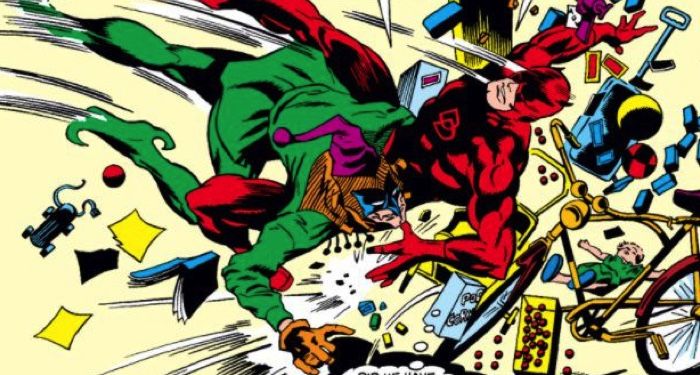
Early Daredevil Villains Are Just the Worst
Quick, name a Daredevil villain. Was it Kingpin? Of course it was. Daredevil’s rivalry with Wilson Fisk is the stuff of career-making storylines and Netflix TV shows. And yet, if you really want to get picky, Kingpin debuted as a rival for Spider-Man, not Daredevil. Doesn’t Daredevil have any of his own bad guys? Well, yes…technically.
Here at Book Riot, we’ve done several lists about the best supervillains. This is not one of them. Daredevil literally had no “best” villains in the 1960s. I have read every regular issue (i.e. no annuals) of Daredevil with a ’60s cover date—that’s Issues 1–59—so I speak from personal experience when I say that early Daredevil villains are all varying flavors of hilariously terrible, forgettably terrible, and terrible terrible. It’s amazing that Daredevil lasted so long without getting even a sniff at a decent arch-nemesis.
Just to clarify, I mean no harm with this article. The Silver Age of comics holds a special place in my heart, and I genuinely love seeing these idiots running around attacking people with capes and stilts and popcorn. The more I insult them, the more I love them. With that in mind, let’s get started. I suggest you prepare yourselves for an abundance of purple and frogs.
Daredevil #1–5
Honestly, the first crop of baddies isn’t all that bad. In his debut issue, Daredevil fights not a supervillain but a boxing manager, the Fixer, who was responsible for the death of DD’s father. It’s a pretty straightforward revenge tale. I can imagine it appearing in a pulp magazine without the weird “I can feel colors with my fingers” stuff.
Similarly, the Owl and the Purple Man are both fairly serious villains despite their gimmicks. The former is a wealthy crime lord, and the latter just smiles nicely as he mind-controls people into doing his bidding. All told, it’s a surprisingly good foreshadowing of Daredevil’s future as a gritty, down-to-earth type hero.
But even in these early days, signs of trouble loom. In his second issue, Daredevil faces Electro, a Spider-Man villain. Okay, so maybe they brought him in to boost the still-new Daredevil title, right? Surely this isn’t a sign that the creators were already out of ideas and raided Spidey’s rogues gallery out of desperation?
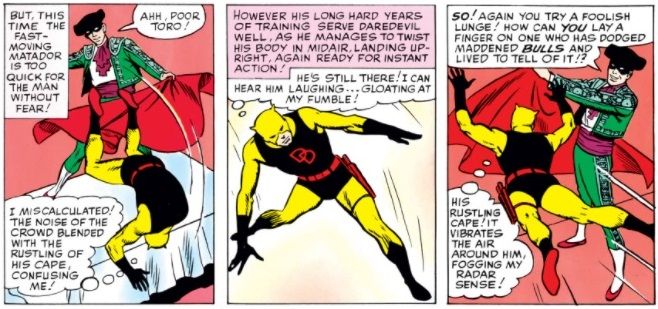
This is the Matador. He is a matador. With a mask!
His backstory makes it even worse. For some reason, this guy thinks robbing people on a different continent is a good way to get back at the Spanish spectators who rejected his extreme cruelty. His only power is his ability to render Daredevil helpless by flipping his cape over DD’s head, which seems more of a comment on Daredevil’s own suckiness than the Matador’s skill.
Daredevil #6–10
In his sixth issue, Daredevil borrows from not one but two other heroes’ villain rosters: the Ox, another Spider-Man villain, and the Eel, a Human Torch villain. But lest you think the creative team was completely lazy, these two team up with an original villain, Mr. Fear, an evil Madame Tussaud–type who accidentally invented a fear gas when trying to bring his wax figures to life. He must be fun at parties.
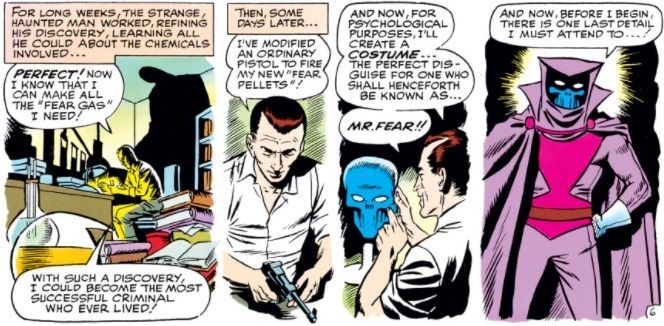
Mr. Fear would go on to an illustrious career of dying in prison. But we’ll get to that.
Between bouts with a litigious Sub-Mariner and a forgettable Doctor Doom knockoff, Daredevil finally meets the legend himself: STILT-MAN.
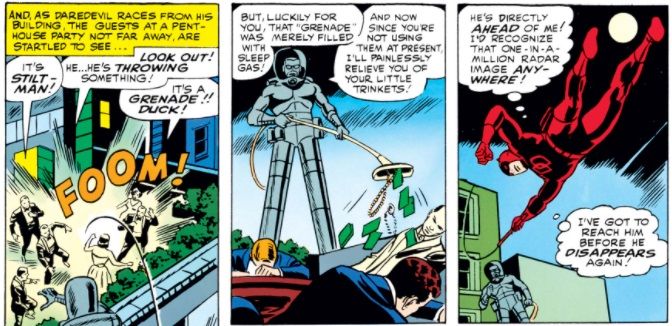
Yes, Stilt-Man, that much-maligned symbol of Silver Age supervillainy. Whenever someone wants to mock old-school supervillains, Stilt-Man usually gets dragged into the conversation, and…yeah, I get it. He’s very visually goofy. This is why I love him. Despite appearing to die at the end of the issue, Stilt-Man would return before the decade was out. Take THAT, Mr. Fear.
Finally, Issue 10 brings us the Organizer, which sounds like a superhero name for Marie Kondo. He runs a crime syndicate called…wait for it…the Organization. His henchmen are Cat Man, Bird Man, Ape Man, and Frog Man, who are criminals dressed as…well, you know. Also, I feel the need to tell you that the Organizer outfits these henchmen with cameras called—I kid you not—”creepy-peepy” TV cameras.
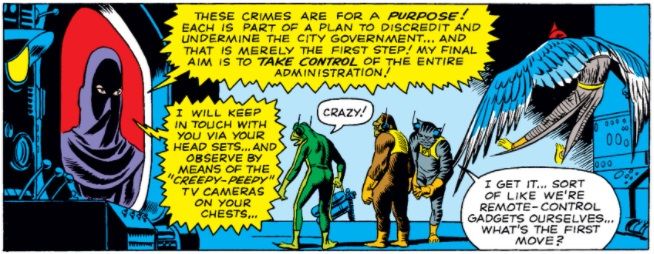
If it makes you feel better, these Ani-Men (as they were later known) got a superpowered upgrade in the ’70s when they fought the X-Men. Frog Man still sucked, though, because there’s only so much you can do with a name like that.
Daredevil #11–15
Here’s where things really go off the rails. In Issues 12 through 14, Daredevil teams up with Ka-Zar, the be-loinclothed ruler of the primitive Savage Land. The baddie? A pirate/English lord named the Plunderer who also happens to be Ka-Zar’s evil brother. This means Ka-Zar’s birth name is Kevin Plunder, a fact I now plan to expunge from my memory forever. There’s also a halfhearted subplot about foreign spies, and Daredevil punches a caveman.
In Daredevil #15, some mad scientist trades bodies with the Ox and then dies. This leaves Ox, still in the scientist’s body, free to begin a new life as an ordinary person—an interesting development that would not bear fruit until 1972.
Daredevil #16–20
Ah, finally, the inevitable Daredevil/Spider-Man team-up. Together, they take on the Masked Marauder, a guy with a tissue over his face and an unhealthy love of the color purple. Not the book, the actual color.
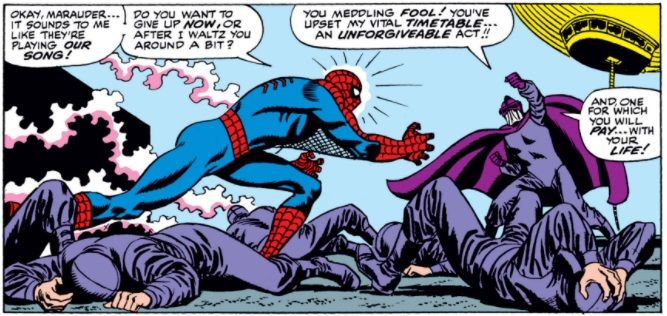
While Marauder debuted in Daredevil and would go on to face DD sans Spidey, you could make a good argument that he’s a Spider-Man villain, too: Spidey is his main target here. Daredevil is just the tool he uses to distract him. The same thing happened in the Electro issue: Electro wanted to raid the Fantastic Four’s headquarters and Daredevil just kind of stumbled into the way. I know we’re in a shared universe, but DD is stealing other people’s baddies left and right here.
Next up is the Gladiator, whose “clothes make the man” attitude drives him to attach buzzsaws to his wrists in the belief that this will make him better than Daredevil.
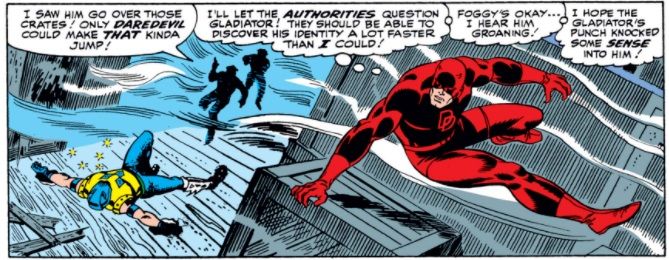
The Gladiator and the Masked Marauder then team up to get revenge on Daredevil, but shockingly, two losers are not better than one.
Daredevil #21–25
There was only one new villain introduced during these five issues. Brace yourselves.
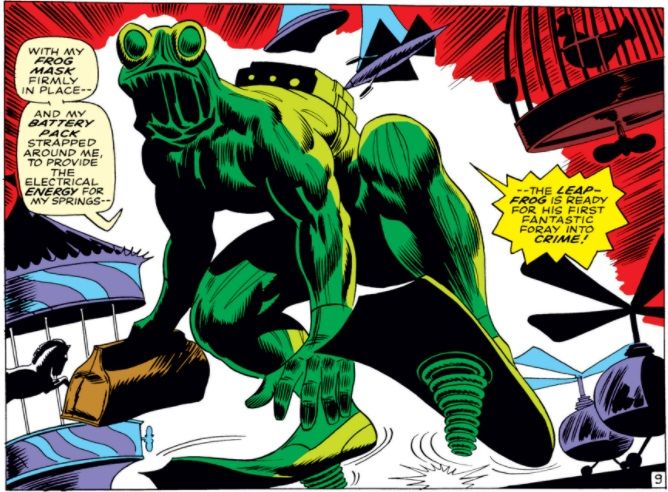
Aside from designing the most horrifying frog costume I’ve ever seen, Leapfrog is just a petty thief. Daredevil defeats him by punching him into water. The FROG-THEMED villain loses in WATER.
Oh, but we’re not done with him yet. In the next issue, Leapfrog attempts to escape his own trial by jumping out a window, only to belatedly realize that the fasteners on his shoes have been removed. One shoe falls off, causing him to break his leg. Dangit, how many years till Elektra shows up?
Daredevil #26–30
After the return of Stilt-Man and the Masked Marauder, Daredevil is kidnapped by aliens—who also look like frogs, somehow—who want to blind everyone on Earth and steal our minerals. Which minerals? ALL OF THEM.
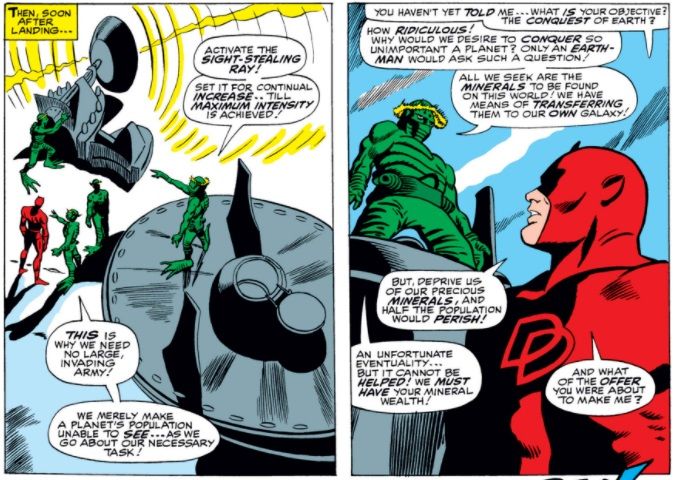
By comparison, DD’s next opponent seems pretty dull. (I’m kidding, of course. He would be dull anyway.) Known only as the Boss, he’s a crime boss (GET IT?) in a Dick Tracy coat who attempts to take over the missing Masked Marauder’s gang.
Unsurprisingly, in Daredevil #30, we go back to stealing baddies from other heroes—specifically, Cobra and Mr. Hyde from Thor. Daredevil figures it’ll be easier to find them if he dresses as Thor himself, but he doesn’t get to see if his plan would work before the actual Thor shows up and tells him to cut it out. Thor guards his copyright zealously.
Daredevil #31–35
The Cobra/Hyde fight lasts for three issues, ending with Issue 32. After that, Daredevil confronts two Human Torch baddies in quick succession: the Beetle and the Trapster.
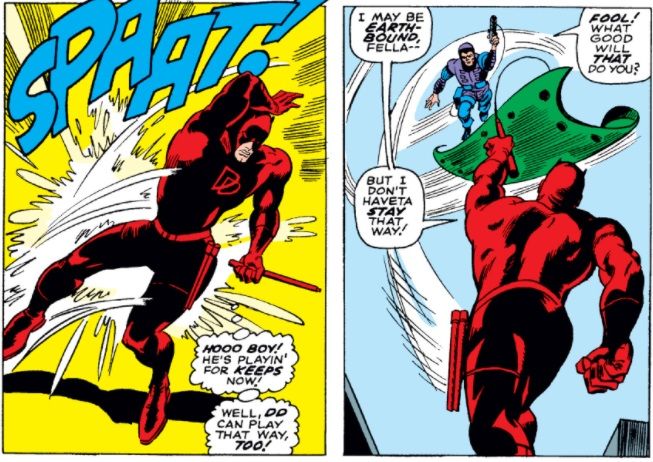
Fun Fact: The Trapster originally called himself Paste Pot Pete. He has been rightfully roasted for this ever since.
Daredevil #36–40
By Issue 37, Daredevil is still greedily swiping Fantastic Four villains, but this time he nets a good one: Doctor Doom himself. Doom even switches bodies with DD but somehow avoids finding out dude is blind. I guess the power of suck that pervades this comic clouded the good doctor’s common sense.
This is followed by the return of the Ani-Men, who are now under the direction of the Exterminator.
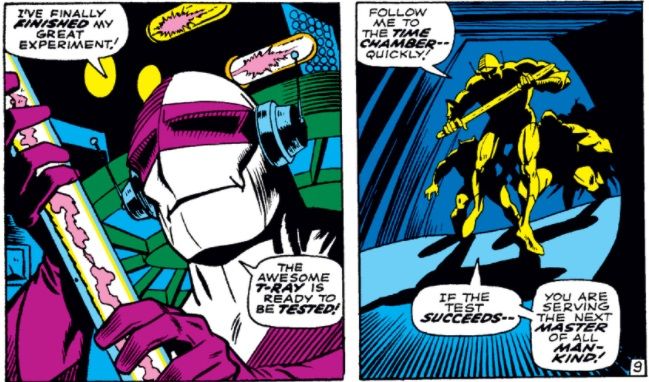
Who is he? Why does he want to master time? Why is his face like that? Heck if I know. The comic tells us absolutely nothing about him. For my money, this makes him way worse than Stilt-Man or even the Matador. Those two have backstories and memorable looks, if nothing else. What’s the Exterminator got? Funky headphones? At least stick with the theme and give him a canister of bug spray.
(To be fair, like the Ani-Men, the Exterminator would go on to receive an upgrade. But, also like the Ani-Men, that wouldn’t happen until the ’70s. As of the 1960s, this is all we get.)
Daredevil #41–45
In Daredevil #42, we are introduced to the Jester, a far inferior version of DC’s Trickster.
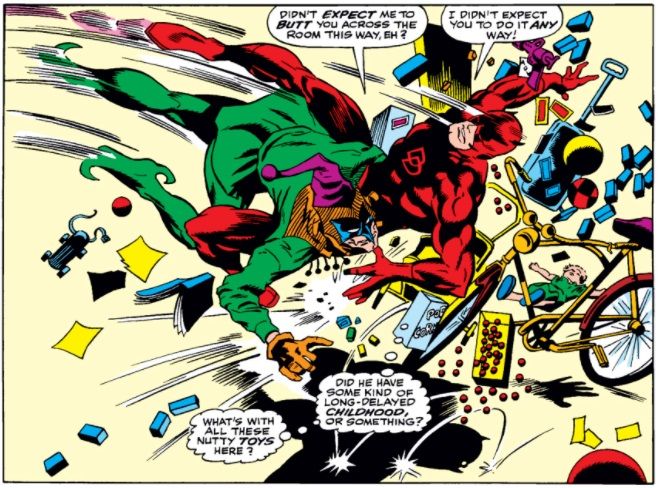
While I’m always a sucker for a fun gimmick, the Jester, like the Matador, is given an origin that doesn’t match his modus operandi. In his civilian life, he was a frustrated actor who could only find work as a vaudeville stooge. He became the Jester to provide the public with “laughter at the expense of someone else,” i.e. his victims.
But none of his crimes reflect that goal. How does robbing banks at night with no witnesses make people laugh? Or secretly agreeing to do a politician’s dirty work? Or faking his own death and framing Daredevil for his “murder?” Granted, that last plot was pretty interesting, but it doesn’t get him closer to his stated goal. What are you doing with your life, Jester???
Daredevil #46–50
Daredevil #47 is the title’s first attempt at what I call “being relevant.” In other words, for this one issue, DD ditches the goofy supervillains to help a blind, Black Vietnam vet clear his name after a mobster, Biggie Benson, frames him for bribery.
Yes, this issue is somewhat naïve and preachy. But I like it for allowing us to see Matt Murdock kick someone’s keister in the courtroom for once. Benson may not be the most exciting villain, but he suits the story. He even represents something of a return to form for Daredevil, who, as you’ll recall, began his career by defeating a crooked fight promoter.
This does not last.
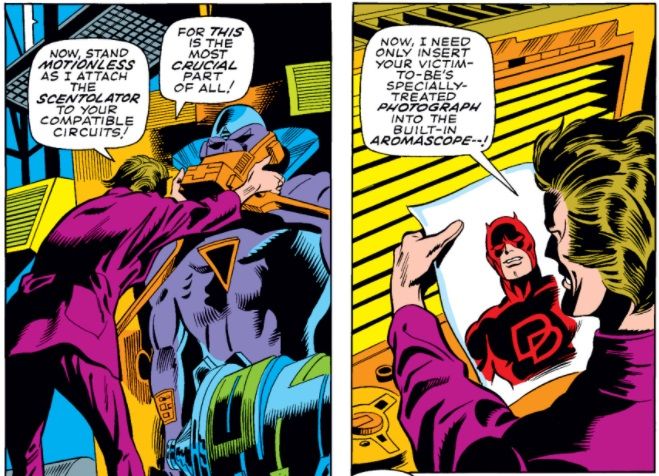
After Benson goes to jail, he hires this weirdo, Starr Saxon, to kill Daredevil. Saxon decides to do this by building an invincible robot that can locate anyone by smell. With that kind of creativity, it’s probably a good thing Saxon never got around to giving his ‘bot a name. Then again, he plans to market his robot’s services to other bad guys after it kills DD, so giving the thing a name might help with branding.
Daredevil #51-55
Saxon may be weird and lazy, but he does manage to figure out Daredevil’s secret identity and blackmail him with it. As a result, in Issue 54, DD fakes Matt Murdock’s death. During this time, he tangles with Mr. Fear again, only to find out that the real Fear was killed in prison and had his identity stolen by none other than Starr Saxon. Saxon then just conveniently falls to his death. Or so Daredevil says.
Daredevil #56-59
After following/stalking his not-girlfriend, Karen Page, to her hometown of Fagan Corners, Vermont (those names should sound familiar to those of you who read my articles), Daredevil encounters this, uh, person?
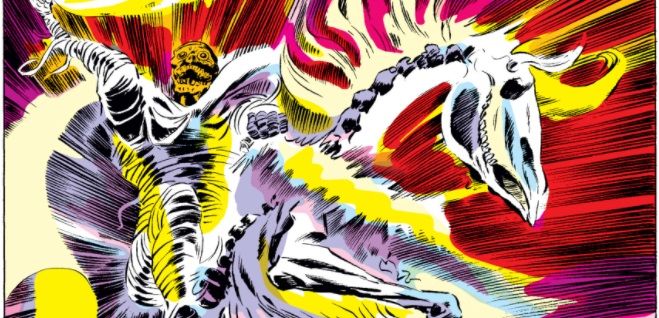
Meet Death’s Head! Despite looking like he’s trying on three different costumes at once (I see a skeleton horse, mummy bandages, and a ceremonial death mask wrapped in a Sleepy Hollow reference?), I dig it.
Death’s Head turns out to be Karen’s dad Paxton Page, a scientist who developed radiation poisoning, which somehow turned him into a supervillain. It’s a neat concept! So much so that, in a shocking reversal, Spider-Man would go on to use a similar concept in 1971’s Amazing Spider-Man #96 with Green Goblin’s chemical-induced return to villainy.
On the flip side, this just emphasizes the fact that Daredevil‘s creative teams have no idea what they’re doing, villain-wise. They come up with this great villain (the father of a close friend who becomes a bad guy without knowing it) and throw it away on a one-shot like Death’s Head.
Daredevil ends the ’60s and begins the ’70s in battle with Crime-Wave, a Moriarty-like figure who runs a crime syndicate from the shadows. Also like Moriarty, Crime-Wave hires a succession of sucktacular assassins to try to kill his nemesis. First is Stunt-Master, a washed-up stuntman who is almost immediately taken out by his own flying motorcycle.
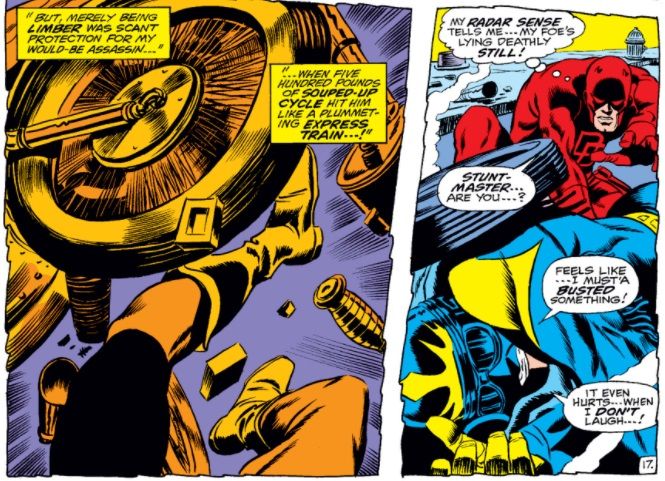
Then there’s the Torpedo, who looks like he started to design a standard supervillain get-up, only to change his mind and try to turn it into a gunslinger costume at the very last second.
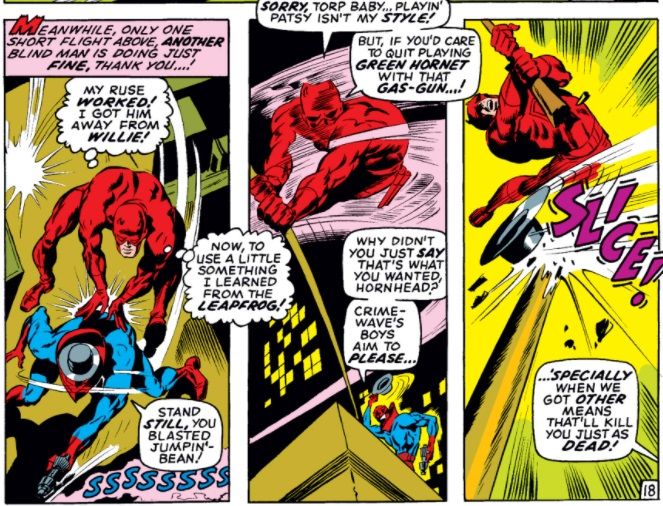
Okay, first off, I refuse to believe you learned anything useful from LEAPFROG. Second, apparently Daredevil watches Green Hornet? I have questions.
Of the two, I would say Torpedo sucks worse than Stunt-Master. His target was actually Willie Lincoln, the Vietnam vet introduced a few issues ago, not Daredevil. And yet, Daredevil leaves Torpedo and an unconscious Willie alone, running up to the roof in the hopes that Torpedo is angry enough to follow him without taking the literal two seconds necessary to shoot Willie dead before leaving. And it works. Small wonder a groggy Willie manages to tackle him off the roof.
Finally, lest you go away thinking Crime-Wave will be a formidable villain of any sort, he is unmasked in Daredevil #60 as an extremely minor character we barely got to know, and he never shows up again. Typical.
















